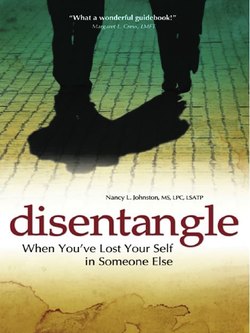Читать книгу Disentangle - Nancy L. Johnston - Страница 11
На сайте Литреса книга снята с продажи.
ОглавлениеPreface to the First Edition
Recently I took a walk with a good friend of mine along the river that runs by our homes. We were walking our dogs and talking about the final stages of this book. She has been very interested in and supportive of this project. Over its development we have talked about its contents and their applicability to our lives. We continue to do so. We are also now talking about the details of putting it into print and distributing it beyond our community.
As we sat on a fallen tree and watched the river flow by, I reflected on what a life project this has been for me. As you will find in reading Disentangle, it has evolved as I have evolved. There were times when I truly felt lost in someone else, as though I was lost in the woods. I would feel terribly overwhelmed by the situation with this other person and have no idea what to do about it or how to help my self find my way back to my own security and peace of mind.
I have chosen to use the picture of the tree on the front of this book for at least a couple of reasons known to me. The tree is in my front yard and is positioned outside the window out of which I look as I have written this book. It has been my constant companion and has endured many seasons, as has the writing of this book that now totals eight years in the making. I have also chosen to use the picture of the tree because it represents both lostness in the woods and the finding of our way out of the woods, as suggested by the light shining through the expanding branches. I have learned that by applying the ideas of disentangling to my life, I experience the same type of openings, expansions, and light, and in so doing, I find my self and am no longer lost.
As you may have already noticed in my writing here, I am separating the word “self” from possessives such as “my” and “your.” This is intentional on my part. I want to emphasize the word “self.” It is, in fact, what this book is largely about, and I am interested in helping the reader to keep that word, that concept, that important reality in mind. Disentangle is about finding our self when we have lost it in someone else. It is about learning how to connect with our self and then knowing how to respond to it in ways that make us stronger, clearer, and more serene.
I find my self unable or unwilling to try to express specific acknowledgments for help with this book, and I choose not to dedicate it to any one person. So many people have been involved in my life and in the writing of this book, both directly and indirectly, that I could not adequately list them, thank them, or offer a narrowed dedication.
With this in mind, I will say that this book is gratefully offered by me to each of you who have an interest in making your life better by taking the time and energy to look at your self and make the changes that will help you to be centered and happier as you interact with people in your life. This book is not about changing them. It’s about changing you so that you can enjoy life, others, and especially your self.
And so, my friend and I continued on our walk by the river, leaving the fallen tree and making our way back to the path through the woods. The dogs knew the way home, and so did we. The path was fresh and clear. Our spirits were bright and energized. I was glad to be where I was, knew where I was going, and felt very content.
I trust that the ideas in this book can similarly offer each of us a path to a peaceful and centered self.
Nancy L. Johnston January, 2003
Please note: Interspersed throughout Disentangle you will find experiential exercises that provide valuable opportunities to practice applying the material to your life. I encourage you to complete these exercises in a separate journal. They will help you expand your awareness and build skills toward healthier relationships with others, and with your self.
